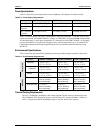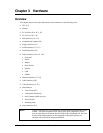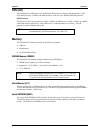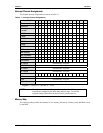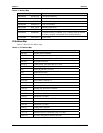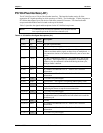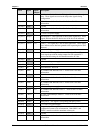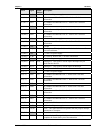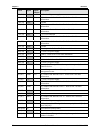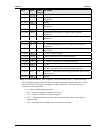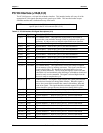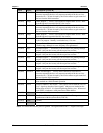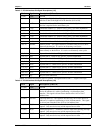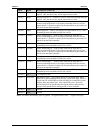
Chapter 3 Hardware
LittleBoard 550 Reference Manual 27
Pin # Signal Input/
Output
Description
45 (B15) +3.3V +3.3 volts ±5% power supply
46 (B16) AD20
T/S
PCI Address and Data Bus Lines 20 – Refer to Pin 3 for more
information.
47 (B17) AD23
T/S
PCI Address and Data Bus Line 23 – Refer to Pin 3 for more
information.
48 (B18) GND Ground
49 (B19) C/BE3*
T/S
PCI Bus Command/Byte Enable 3 – Refer to Pin 4 for more
information.
50 (B20) AD26
T/S
PCI Address and Data Bus Line 26 – Refer to Pin 3 for more
information.
51 (B21) +5V +5 volts ±5% power supply
52 (B22) AD30
T/S
PCI Address and Data Bus Line 30 – Refer to Pin 3 for more
information.
53 (B23) GND Ground
54 (B24) REQ2*
T/S
Bus Request – This signal indicates this device desires use of the
bus to the arbitrator.
55 (B25) VI/O +5 volts ±5% power supply
56 (B26) CLK0
In
PCI clock 0– Refer to Pin 27 for more information
57 (B27) +5V +5 volts ±5% power supply
58 (B28) INTD*
O/D
Interrupt D – This signal is used to request interrupts only for
multi-function devices.
59 (B29) INTA*
O/D
Interrupt A – This signal is used to request an interrupt.
60 (B30) NC Not connected - Reserved
61 (C1) +5 +5 volts ±5% power supply
62 (C2) AD01
T/S
PCI Address and Data Bus Line 1 – Refer to Pin 3 for more
information.
63 (C3) AD04
T/S
PCI Address and Data Bus Lines 4 – Refer to Pin 3 for more
information.
64 (C4) GND Ground
65 (C5) AD08
T/S
PCI Address and Data Bus Line 8 – Refer to Pin 3 for more
information.
66 (C6) AD10
T/S
PCI Address and Data Bus Line 10 – Refer to Pin 3 for more
information.
67 (C7) GND Ground
68 (C8) AD15
T/S
PCI Address and Data Bus Line 15 – Refer to Pin 3 for more
information.
69 (C9) SB0* NC Snoop Backoff – Not connected
70 (C10) +3.3V +3.3 volts ±5% power supply
71 (C11) LOCK*
S/T/S
Lock – This signal indicates an operation that may require multiple
transactions to complete
72 (C12) GND Ground
73 (C13) IRDY*
S/T/S
Initiator Ready – This signal indicates the master’s ability to
complete the current data cycle of the transaction



